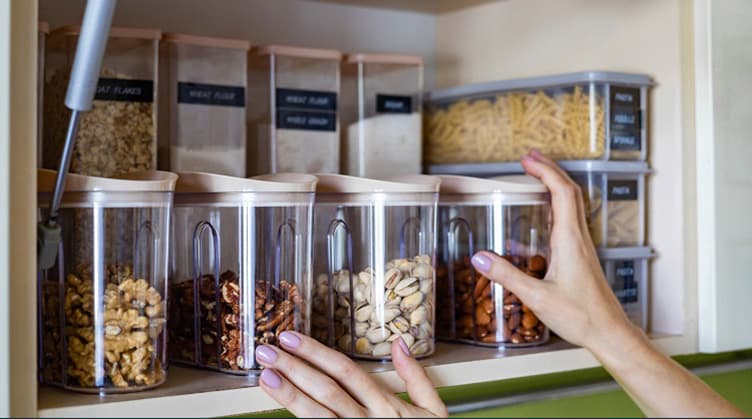
Best Life Hacks for Rheumatoid Arthritis in the Home
April 27, 2023 | Patient SpotlightRheumatic Disease

When you live with rheumatoid arthritis (RA), the smallest daily tasks can be difficult, from getting dressed to making dinner.
After living with RA for 19 years and obtaining a master’s in occupational therapy, I’ve developed a deep love for life hacks, or daily adaptations that can reduce strain on my joints and allow me to function more independently!
Most of these are based on principles of “joint protection,” which means strategies to reduce unnecessary force and strain on your joints during daily tasks.
In this blog post, I’ll be sharing some of my favorite tips, tricks, and tools for rheumatoid arthritis in the home, organized by room.
Front Entrance of the Home or Apartment
Sometimes the most important life hack is one that allows you to get into the home in the first place—anyone who’s struggled to twist a key into a stubborn lock can identify with this struggle!
I use an adaptive gadget which goes on top of my keys and effectively adds “wings” to the sides to make it much easier to grasp and twist. This takes strain off my tender thumb and pointer finger joints.
Additionally, many with RA find that doorknobs shaped like horizontal levers are much easier to open and close than round, or circular doorknobs. I have replaced all the circular knobs in my home with lever knobs.
Another adaptation for home entry would be “smart home” items, like a keypad to enter the front door rather than a knob. Some can even be controlled from a smart phone using voice commands.
Another consideration is how many steps there are to enter your home or apartment. If you have hip or knee pain, steps can add to difficulty.
Bathroom and Toileting
- Raise the toilet seat: getting a “raised toilet seat” can help if you have hip pain in particular.
- Grab bars for stability: Adding grab bars to the side of the toilet can make it easier to get onto and off of it.
- Wiping aids: There are long handled toilet wiping aids which help if you have decreased shoulder range of motion or back pain.
- Bidet versus traditional American toilet: Many find that a bidet is much easier to use for cleaning after a bowel movement than toilet paper.
- Sink style: Similar to the doorknob concept, I find that lever style sink faucets are easier to use than circular knob ones. Additionally, I have installed a “hand wave” operated faucet which allows me to turn it on without even touching it - this is great for sore or stiff hands!
Kitchen and Cooking
If you search for “arthritis gadgets for kitchen” on Google, you will see over six million results, showing that this is a very popular topic and area of concern for people with hand pain from RA or other forms of arthritis!
Here are the main categories of life hacks I consider in the kitchen:
- Opening aids: One of the tools I use the most is a simple plastic multi-opener tool, which can open different sized jars as well as water bottles. Additionally, many find that having an electronic can opener is easier than a hand operated one.
- Cutting / chopping aids: Did you know that there are hundreds of different designs to the basic kitchen knife? I use a “handle knife,” which has a handle at a 90-degree angle to the blade; when I grip this handle and cut, I avoid unnecessary strain on my knuckle and thumb joints. Other options include a rocker knife, electronic food chopper, or a “slap chop” style chopper.
- Overall kitchen organization: One of the simplest and cheapest things you can do to make your kitchen more arthritis-friendly is to reorganize it so that items you use most often are between your shoulder and hip level. It can also help to pour large, heavy items into smaller containers.
- Kitchen appliance considerations: I just went through a kitchen remodel, and I was *shocked* at how each kitchen appliance was different when it comes to ease of use. For example, some refrigerators were so difficult to open that I needed to use two hands, and others required awkward grips or hand positions that would not be good for my joints over time. On the positive side, there were some exciting new developments including a “hand wave” operated drawer microwave! I highly recommend trying out appliances before purchasing them, and also considering the ideal height for you. For example, I have a lower down microwave than most people as that’s easier for me to use when it comes to hand and shoulder pain.
- Fatigue management tips: Fatigue can pose a considerable barrier in the kitchen; some things that can help include stools for sitting and taking rest breaks, an anti-fatigue mat to stand on, “chunking out” food prep tasks so that you’re not doing them all at once and using workarounds such as pre-chopped food that can save you energy.
Bedroom
Sleep is an incredibly important lifestyle factor for managing rheumatoid arthritis stress and inflammation. Some things to consider to make your bedroom activities more comfortable include:
- Bed rails or bed ladders: These can help you get into and out of the bed if you’re having hip pain
- Sleep positioning: It’s important to assume positions during rest that don’t contribute to additional deformities; occupational therapists can help recommend resting hand splints which may prevent ulnar drift. They can also help you experiment with different pillows and set-ups to achieve a symmetrical position.
- Sleep hygiene and routines: Having a consistent, relaxing bedtime routine can help you get better sleep.
- Intimacy: Occupational therapists can help you work through ways that your arthritis may affect your sexual activity participation and sex life. This may include timing medication to sexual activity, scheduling intimate activities in advance for times of the day when you feel your best, and experimenting with different positions that put less strain on your body.
Conclusion
Tips, tricks, and tools can help you better manage your RA within your home, and this is just the tip of the iceberg when it comes to home modifications and life hacks! If you have more questions, don’t forget that occupational therapy practitioners specialize in precisely these topics, as well as ways for you to re-engage in meaningful activities and routines.

